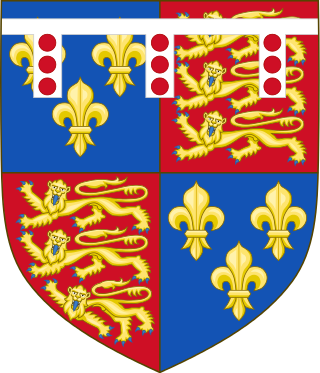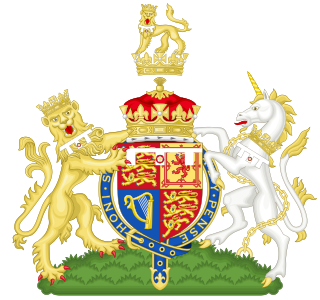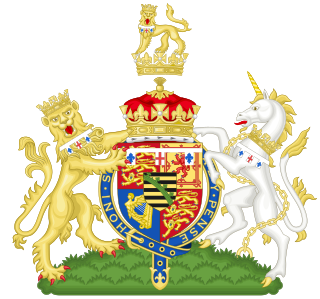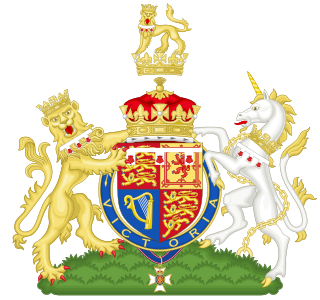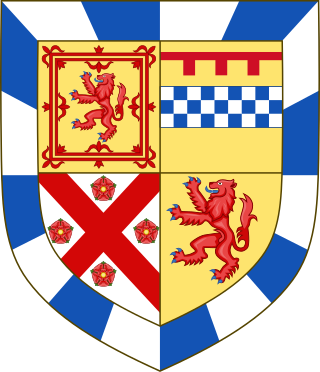Robert II
(1316–1390) | | | | | | | | | | | | | | King Edward III
(1312–1377) |
|
| | | | | | | | | | | | | | | | | | | | | | | | | | | | | | | | | | | | | | | |
| | | | | | | | | | | | | | | | | | | | | | | | | | | | | | | | | |
| | | | | Duke of Albany (1st creation), 1398 | | | | | | | Duke of Clarence (1st creation), 1362 | | | | | | | | | | | | | | | Duke of York (1st creation), 1385 | | | | | |
|
Robert III
(c. 1337–1406) | | Robert Stewart
(c. 1340–1420)
1st Duke of Albany | | Edward the Black Prince
(1330–1376) | | Lionel of Antwerp
(1338–1368)
Duke of Clarence | | | | | | John of Gaunt
(1340–1399) | | | | | | Edmund of Langley
(1341–1402)
1st Duke of York | | | | | |
|
| | | | | | | | | | | | | | | Dukedom of Clarence (1st creation) extinct, 1368 | | | | | | | | | | | | | | | | | | | | | | | | | |
| | | | | | | | | | |
| | | | | | | | | | Duke of Cornwall (2nd creation), 1376 | | | | | | Duke of Hereford, 1397 | | | | | | | | | | | | | | | | | Duke of Gloucester (1st creation), 1385 |
|
| | | | | Murdoch Stewart
(c. 1362–1425)
2nd Duke of Albany | | Richard of Bordeaux
(1367–1400)
Duke of Cornwall, later King Richard II | | | | | | Henry Bolingbroke
(1367–1413)
1st Duke of Hereford, later King Henry IV | | | | | | | | | | | | | | | | | Thomas of Woodstock
(1355–1397)
Duke of Gloucester |
|
| | | | | Dukedom of Albany (1st creation) forfeit, 1425 | | Dukedom of Cornwall (2nd creation) merged in the crown, 1377 | | | | | | Dukedom of Hereford merged in the crown, 1399 | | | | | | | | | | | | | | | | | Dukedom of Gloucester (1st creation) extinct, 1397 |
|
| | | | | | | | | | | | | | | | | | | | | | | | | | | | | | | | | | | | | | | | | |
| | | | | | | | | | | | | | | |
| | | | | | | | | Duke of Clarence (2nd creation), 1412 | | Duke of Bedford (1st & 2nd creations), 1414 | | Duke of Gloucester (2nd creation), 1414 | | | | | | | | | | | | Duke of Albemarle (Aumale) (1st creation), 1397 | | | | | |
|
| | | | | | | | | Thomas of Lancaster
(1387–1421)
Duke of Clarence | | John of Lancaster
(1389–1435)
Duke of Bedford
Surrendered dukedom and then regranted, 1433 | | Humphrey of Lancaster
(1390–1447)
Duke of Gloucester | | John Beaufort
(1373–1410) | | Joan Beaufort
(c. 1379–1440) | | Edward of Norwich
(c. 1373–1415)
Duke of Aumale, 2nd Duke of York | | Richard of Conisburgh
(1385–1415) |
|
| | | | | | | | | Dukedom of Clarence (2nd creation) extinct, 1421 | | Dukedom of Bedford (2nd creation) extinct, 1435 | | Dukedom of Gloucester (2nd creation) extinct, 1447 | | | | | | | | | | | | Dukedom of Albemarle (Aumale, 1st creation) forfeit, 1399 | | | | | |
|
| | | | | | | | | | | | | | | | | | | | | | | | | | | | | | | | | | | | | Duke of York (1st creation) restored, 1425
Duke of Cornwall (3rd creation), 1460 |
| | | | | | | | | | | | | | | | | | | | | | | |
James I
(1394–1437) | | Joan Beaufort
(c. 1404–1445) | | | | | | John Beaufort
(1404–1444) | | | | | | | | | | Richard Neville
(1400–1460) | | Cecily Neville
(1415–1495) | | Richard of York
(1411–1460)
3rd Duke of York, Duke of Cornwall |
| | | |
| | | | | | | | | | | | | | | | | | | | | | | | | | | | | | | | | | | | | | | | Duke of Cornwall (3rd creation) extinct, 1460 |
| | | | | | | | | | | | | | | | | | | |
| | | | | | | | | | | | | | | | | | | | | | | | | | | | | | | | | | | | | | | | | | |
| | | | | | | | | | |
| | | | | Duke of Bedford (5th creation), 1485 | | | | | | | | | | | | | | | | | | | | | | | | | | Duke of Clarence (3rd creation), 1461 | | Duke of Gloucester (3rd creation), 1461 |
|
James II
(1430–1460) | | Jasper Tudor
(c. 1431–1495)
Duke of Bedford | | Edmund Tudor
(c. 1430–1456) | | Lady Margaret Beaufort
(1443–1509) | | John Neville
(c. 1431–1471) | | Elizabeth Woodville
(c. 1437–1492) | | Prince Edward
(1442–1483)
4th Duke of York, later King Edward IV | | George Plantagenet
(1449–1478)
Duke of Clarence | | Richard of York
(1452–1485)
Duke of Gloucester, later King Richard III |
| | | |
| | | | | Dukedom of Bedford (5th creation) extinct, 1495 | | | | | | | | | | | | | | | | | | | | | | Dukedom of York (1st creation) merged in the Crown, 1461 | | Dukedom of Clarence (3rd creation) forfeit, 1478 | | Dukedom of Gloucester (3rd creation) merged in the Crown, 1483 |
| | | | | |
| | | | | | | | | | | | | | | | | | | | | | | | | | | | | | | | | | | | | | | | | | |
| | | | | | | | | | | | | | | | | | | | | | | | | | | |
| Duke of Albany (2nd creation), 1458 | | | | | | | | | | | Duke of Bedford (3rd creation), 1470 | | | | | | | | | | | | | | | | Duke of York (2nd creation), 1474
Duke of Norfolk (3rd creation), 1477 | | Duke of Bedford (4th creation), 1478 |
|
Alexander Stewart
(c. 1454–1485)
1st Duke of Albany | | James III
(1451/1452–1488)
| | | | | | George Neville
(1457–1483)
Duke of Bedford | | King Henry VII
(1457–1509) | | Elizabeth of York
(1466–1503) | | | | | | Richard of Shrewsbury
(1473–1483)
Duke of York, Duke of Norfolk | | George of York
(1477–1479)
Duke of Bedford |
| |
| | | | | | | | | | | | | | | Dukedom of Bedford (3rd creation) forfeit, 1478 | | | | | | | | | | | | | | | | | Dukedom of York (2nd creation) and Dukedom of Norfolk (3rd creation) extinct, 1483 | | Dukedom of Bedford (4th creation) extinct, 1479 |
| | | | | | | | | | | | | | | |
| | | | | Duke of Ross (1st creation), 1488 | | | | | | | | | | | | | | | | Duke of York (3rd creation), 1494 | | Duke of Somerset (3rd creation), 1499 |
|
John Stewart
(1482–1536)
2nd Duke of Albany | | James Stewart
(1476–1504)
Duke of Ross | | James IV
(1473–1513)
| | | | | | Margaret Tudor
(1489–1541) | | Prince Henry
(1491–1547)
Duke of York, later King Henry VIII | | Edmund Tudor
(1499–1500)
Duke of Somerset (nominated but probably not invested) |
| | | | | |
| Dukedom of Albany (2nd creation) extinct, 1536 | | Dukedom of Ross (1st creation) extinct, 1504 | | | | | | | | | | | | | | | | | Dukedom of York (3rd creation) merged in the Crown, 1509 | | Dukedom of Somerset (3rd creation) extinct, 1500 |
| | | | | |
| | | | | | | | | | | | | | | | | Duke of Ross (2nd creation), 1514 |
|
| | | | | | | | | | | | James V
(1512–1542) | | Alexander Stewart
(1514–1515)
Duke of Ross |
|
| | | | | | | | Duke of Albany (3rd creation), 1565 | | | | | | | Dukedom of Ross (2nd creation) extinct, 1515 |
|
| | | | | | | | Henry Stuart
(1546–1567)
1st Duke of Albany | | Mary, Queen of Scots
(1542–1587) |
| |
| | | | | | | | | | | | | | | | |
| | |
| | | | | | | | | | | | Prince James
(1566–1625)
2nd Duke of Albany, later King James VI & I |
|
| | | | | | | | | | | | Dukedom of Albany (3rd creation) merged in the Crown, 1567 |
|
| | | | | | | | | | | | | | | | | | | | | | | | | |
| | | | | | | | | | | | | | |
| | | | | | | | | | | | | | | | | Duke of Albany (4th creation), 1604
Duke of York (4th creation), 1605 | | Duke of Kintyre and Lorne, 1602 |
|
| | | | | | | | Princess Elizabeth Stuart
(1596–1662) | | | | | | Prince Charles
(1600–1649)
Duke of Albany, Duke of York, later King Charles I | | Robert Stuart
(1602)
Duke of Kintyre and Lorne |
|
| | | | | | | | | | | | | | | | | Dukedom of Albany (4th creation), Dukedom of York (4th creation) merged in the Crown, 1625 | | Dukedom of Kintyre and Lorne extinct, 1602 |
|
| | | | | | | | | | | | | | | | | | | | | | | | | |
| | | | |
| | | | | | | | | | | | | | | | | Duke of York (5th creation) 1644
Duke of Albany (5th creation), 1660 | | Duke of Gloucester (4th creation), 1659 |
|
| | | | | | | | Sophia of Hanover
(1630–1714) | | | | | | James Stuart
(1633–1701)
Duke of York, Duke of Albany, later King James II | | Prince Henry
(1640–1660)
Duke of Gloucester |
|
| | | | | | | | | | | | | | | | | Dukedom of Albany (5th creation) and Dukedom of York (5th creation) merged in the Crown, 1685 | | Dukedom of Gloucester (4th creation) extinct, 1660 |
|
| | | | | | | | | | | | | | | | | | | | | | | | | | | | | | | | | | | | | | | |
| | | | | | | | | | | | | | | | | | | | | | | | | | | | | | | |
| | | | | | | | | Duke of York and Albany (1st creation), 1716 | | | | | | | Duke of Cambridge (1st creation), 1664 | | | | | | | Duke of Kendal (1st creation), 1666 | | Duke of Cambridge (2nd creation), 1667 | | | | | |
|
| | | | King George I
(1660–1727) | | Ernest Augustus
(1674–1728)
Duke of York and Albany | | Charles Stuart
(1660–1661)
styled Duke of Cambridge | | James Stuart
(1663–1667)
Duke of Cambridge | | Queen Anne
(1665–1714) | | Charles Stuart
(1666–1667)
designated Duke of Kendal | | Edgar Stuart
(1667–1671)
Duke of Cambridge | | Charles Stuart
(1677)
styled Duke of Cambridge |
|
| | | | | | | | | Dukedom of York and Albany (1st creation) extinct, 1728 | | | | | | Dukedom of Cambridge (1st creation) extinct, 1667 | | | | | | | Dukedom of Kendal (1st creation), extinct, 1667 | | Dukedom of Cambridge (2nd creation) extinct, 1671 |
|
| | | | Duke of Cambridge (3rd creation) | | | | | | | | | | | | | | | | | |
|
| | | | Prince George
(1683–1760)
Duke of Cambridge, later King George II | | | | | | | | | | | | | | Prince William
(1689–1700)
styled Duke of Gloucester |
|
| | | | Dukedom of Cambridge (3rd creation) merged with the Crown, 1727 |
|
| | | | | | | | | | | | |
| | | | |
| | | | Duke of Edinburgh (1st creation), 1726 | | Duke of Cumberland (3rd creation), 1726 |
|
| | | | Prince Frederick Louis
(1707–1751)
1st Duke of Edinburgh, styled Duke of Gloucester until created Duke of Edinburgh | | Prince William Augustus
(1721–1765)
Duke of Cumberland |
|
| | | | | | | | | Dukedom of Cumberland (3rd creation) extinct, 1765 |
|
| | | | | | | | | | | | | | | | | | | | | | | | | | | | | | | | | | | | |
| | | | | | | | | | | | | | | | | | | | | | | | | | | | | | |
| | | | | | | | | | | | | Duke of York and Albany (2nd creation), 1760 | | | | | | | | | | | | | | Duke of Gloucester and Edinburgh, 1764 | | Duke of Cumberland and Strathearn, 1766 |
|
| | | | Prince George William Frederick
(1738–1820)
2nd Duke of Edinburgh, later King George III | | | | | | Prince Edward
(1739–1767)
Duke of York and Albany | | | | | | | | | | | | | | Prince William Henry
(1743–1805)
1st Duke of Gloucester and Edinburgh | | Prince Henry
(1745–1790)
Duke of Cumberland and Strathearn |
|
| | | | Dukedom of Edinburgh (1st creation), merged in the Crown, 1760 | | | | | | Dukedom of York and Albany (2nd creation) extinct, 1767 | | | | | | | | | | | | | | Dukedom of Gloucester and Edinburgh unused, 1805–1816 | | Dukedom of Cumberland and Strathearn extinct, 1790 |
|
| | | | | | | | | | | | | | | | | | | | | | | | | | | | | | | | | | |
| | | | | | | | | | | | | | | | | | | | | | | | | | | | | | |
| Duke of York and Albany (3rd creation), 1784 | | Duke of Clarence and St Andrews, 1789 | | Duke of Kent and Strathearn, 1799 | | Duke of Cumberland and Teviotdale, 1799 | | Duke of Sussex (1st creation), 1801 | | Duke of Cambridge (4th creation), 1801 | | | | | | | | | | |
|
Prince Frederick
(1763–1827)
Duke of York and Albany | | Prince William Henry
(1765–1837), Duke of Clarence and St Andrews, later King William IV | | Prince Edward
(1767–1820)
Duke of Kent and Strathearn | | Ernest Augustus
(1771–1851)
King of Hanover, 1st Duke of Cumberland and Teviotdale | | Prince Augustus Frederick
(1773–1843)
Duke of Sussex | | Prince Adolphus
(1774–1850)
1st Duke of Cambridge | | Princess Mary
(1776–1857) | | Prince William Frederick
(1776–1834)
2nd Duke of Gloucester and Edinburgh |
|
| Dukedom of York and Albany (3rd creation) extinct, 1827 | | Dukedom of Clarence and St Andrews merged in the Crown, 1830 | | Dukedom of Kent and Strathearn extinct, 1820 | | | | | | | Dukedom of Sussex (1st creation) extinct, 1843 | | | | | | | | | | | Dukedom of Gloucester and Edinburgh extinct, 1834 |
|
| | | | | | | | | | | | | | | | | | | | | | | | | | |
| | | | | |
| | | | | | | | Queen Victoria
(1819–1901) | | George V
(1819–1878)
King of Hanover, 2nd Duke of Cumberland and Teviotdale | | Prince George
(1819–1904)
2nd Duke of Cambridge | | Princess Mary Adelaide of Cambridge
(1833–1897) |
|
| | | | | | | | | | | | | | | | | | Dukedom of Cambridge (4th creation) extinct, 1904 | | | | | |
|
| | | | | | | | | | | | | | | | | | | | | | | | | | | | | | | | | | | | | | | |
| | | | | | | | | | | | | | | | | | | | | | | | | | | | | | | | | | | |
| | | | | | | | | | | | | | | | | | | Duke of Edinburgh (2nd creation), 1866 | | | | | | | Duke of Connaught and Strathearn, 1874 | | Duke of Albany (6th creation), 1881 | | Duke of Clarence and Avondale, 1890 |
|
| | | | King Edward VII
(1841–1910) | | Princess Alice
(1843–1878) | | Prince Ernest Augustus
(1845–1923)
3rd Duke of Cumberland and Teviotdale | | Prince Alfred Ernest Albert
(1844–1900)
Duke of Edinburgh | | | | | | | Prince Arthur
(1850–1942)
1st Duke of Connaught and Strathearn | | Prince Leopold
(1853–1884)
1st Duke of Albany | | Prince Albert Victor
(1864–1892)
Duke of Clarence and Avondale |
|
| | | | | | | | | | | | | | Dukedom of Cumberland and Teviotdale forfeit, 1919 | | Dukedom of Edinburgh (2nd creation) extinct, 1900 | | | | | | | | | | | | | | | | | Dukedom of Clarence and Avondale extinct, 1892 |
|
| | | | | | | | | | | | | | | | | | | | | | | | | | | | | | | | | | | | |
| | | | | | | | | | | | | | | | | | | | | | | |
| | | | | Duke of York (6th creation), 1892 | | | | | | | | | | | | | | | | | | | | | | | | | | | |
|
Mary of Teck
(1867–1953) | | George Frederick Ernest Albert
(1865–1936)
Duke of York, later King George V | | Princess Victoria of Hesse and by Rhine
(1863–1950) | | | | | | | | | | | | | | Prince Arthur of Connaught
(1883–1938) | | | | | |
| |
| | | | | Dukedom of York (6th creation) merged in the Crown, 1910 | | | | | | | | | | | | | | | | | | | | | | | | | | | |
|
| | | | | | | | | | | | | | | | | | | | | | | | | | | | | | | | | | | | |
| | | | | | | | | | | | | | | | | | | | | | | | |
| Duke of Windsor, 1937 | | Duke of York (7th creation), 1920 | | | | | | | | | | | Duke of Kent (2nd creation), 1934 | | Duke of Gloucester (5th creation), 1928 | | | | | | | | | | |
|
King Edward VIII
(1894–1972)
Later Duke of Windsor | | Prince Albert Frederick Arthur George
(1895–1952)
Duke of York, later King George VI | | Princess Alice of Battenberg
(1885–1969) | | | | | | Prince George
(1902–1942)
1st Duke of Kent | | Prince Henry
(1900–1974)
1st Duke of Gloucester | | Prince Alastair Arthur
(1914–1943)
2nd Duke of Connaught and Strathearn | | Prince Charles Edward
(1884–1919)
2nd Duke of Albany |
|
| Dukedom of Windsor extinct, 1972 | | Dukedom of York (7th creation) merged in the Crown, 1936 | | | | | | | | | | | | | | | | | | | | | Dukedom of Connaught and Strathearn extinct, 1943 | | Dukedom of Albany (6th creation) forfeit, 1919 |
|
| | | | | | | | | Duke of Edinburgh (3rd creation), 1947 | | | | | | | | | | | | | | |
|
| | | | Queen Elizabeth II
(1926–2022) | | Prince Philip
(1921–2021)
1st Duke of Edinburgh | | | | | | Prince Edward
(b. 1935)
2nd Duke of Kent | | | | | |
| |
| | | | | | | | | | | | | | | | | | | | | | | | | | | |
| | | | | | | | | | |
| | | | | | | | | Duke of York (8th creation), 1986 | | Duke of Edinburgh (4th creation), 2023 | | | | | | | | | | |
|
| | | | Prince Charles
(b. 1948)
2nd Duke of Edinburgh, later King Charles III | | Prince Andrew
(b. 1960)
Duke of York | | Prince Edward
(b. 1964)
Duke of Edinburgh | | George Windsor
(b. 1962) | | Prince Richard
(b. 1944)
2nd Duke of Gloucester |
|
| | | | Dukedom of Edinburgh (3rd creation) merged in the Crown, 2022 | | No male heirs | | Dukedom of Edinburgh (4th creation) is a life peerage and therefore not hereditary | | Heir apparent to the Dukedom of Kent | | | | | |
|
| | | | | | | | | | | | | | | | | | | | | | | | | | |
| | | | |
| | | | Duke of Cambridge (5th creation), 2011 | | Duke of Sussex (2nd creation), 2018 | | | | | | | | | | | | | | |
|
| | | | Prince William
(b. 1982)
Duke of Cambridge | | Prince Harry
Duke of Sussex
(b. 1984) | | | | | | Edward Windsor
(b. 1988) | | Alexander Windsor
(b. 1974) |
|
| | | | | | | | | | | | | | | | | | | | | | Heir-apparent to the Dukedom of Gloucester |
|
| | | | Prince George of Wales
(b. 2013) | | Prince Archie of Sussex
(b. 2019) |
|
| | | | Heir apparent to the Dukedom of Cambridge | | Heir apparent to the Dukedom of Sussex |
|






